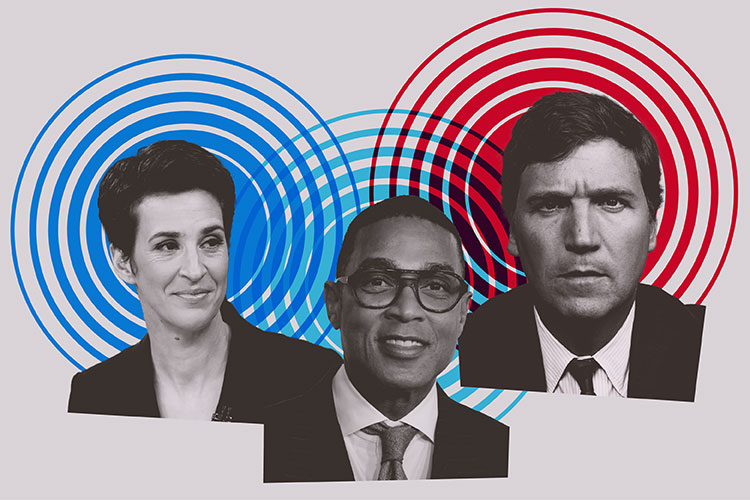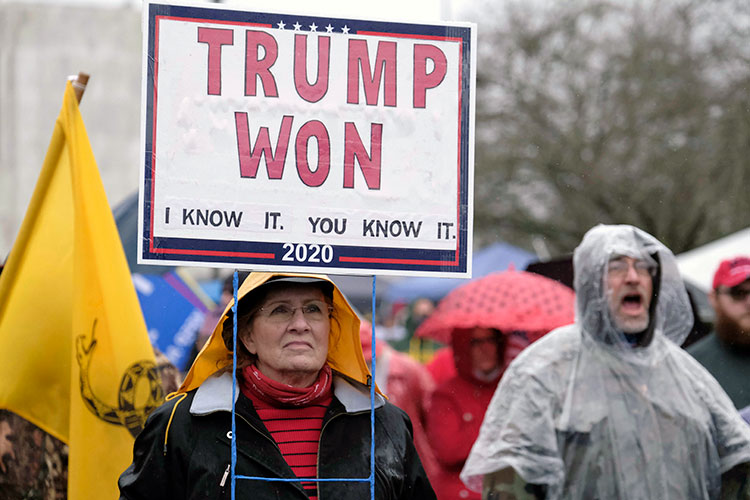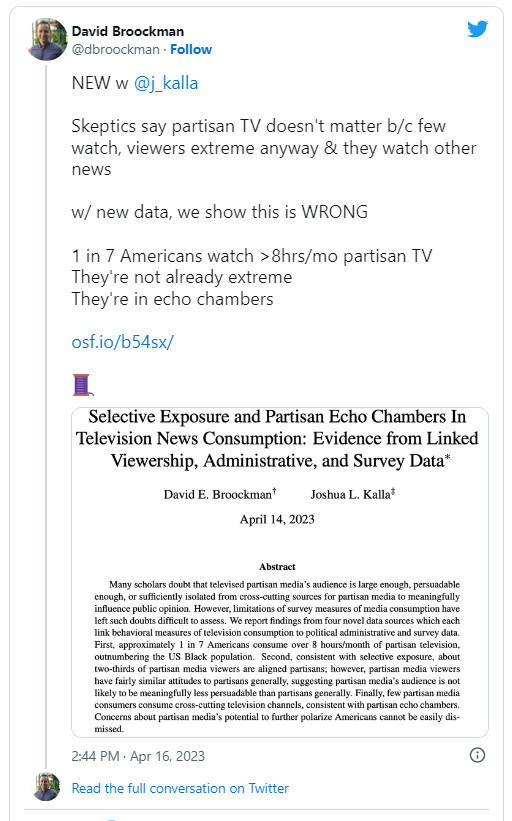Love Fox? MSNBC? You May Be Locked in a ‘partisan echo chamber,’ Study Finds

A startling number of Americans are in “partisan echo chambers,” where they only consume TV news that reinforces their existing political and social biases, according to new research co-authored at UC Berkeley.
In a time of growing concern about divisive media and rising polarization, the new study by Berkeley political scientist David E. Broockman and Berkeley alumnus Joshua L. Kalla of Yale University found that one in five registered Republicans watches at least eight hours of right-wing Fox News per month. Some 15% of Democrats watch a similar amount of coverage on networks MSNBC and CNN.

These numbers represent tens of millions of American TV consumers, Broockman said, some of them already strong partisans, but many whose views are not yet extreme. That suggests a significant bloc of voters could become more extreme and perhaps polarized by a media diet that does not include a more balanced mix of information.
“Most people who tune in to Fox News lean to the right, but Fox draws them further to the right,” Broockman said. “Likewise, MSNBC is pulling those to the left further left. And neither side almost ever watches the other.”
The new research offers a troubling reflection on the American media environment and on risks to the nation’s democracy.
A case in point came just this week, when Fox News agreed to pay $787.5 million to settle claims by Dominion Voting Systems that the network had repeatedly broadcast erroneous reports about fraud associated with Dominion machines — claims that Fox executives and on-air stars apparently knew to be false.
Still, a recent poll found that nearly two-thirds of Republicans continue to believe that Democrat Joe Biden won the presidential election through fraud.
The new research, “Selective Exposure and Partisan Echo Chambers in Television News Consumption: Evidence from Linked Viewership, Administrative, and Survey Data,” was released online. It remains under peer review.
It follows a related paper published by the authors a year ago in which loyal Fox News viewers, after a month of watching CNN instead, reported a broad shift in their political opinions.
The two studies, taken together, “show us that there are a lot of people in partisan echo chambers,” Broockman said. “But our work shows that getting them out of these echo chambers would moderate their views and reduce polarization.”
Innovative use of data yields unprecedented insights
The new Broockman-Kalla study is based on data sets that have never before been tapped by political researchers: data from smart TVs on consumption of partisan and national broadcast news; data from Nielsen Media Research on consumption of partisan and national broadcast news used by its survey subjects, tied to data on their voter party registration; data from TV cable boxes on the media consumption habits; and data from TV consumption diaries tied to survey data on political party affiliation.
Among the findings:
- About 1 in 7 Americans consumes over eight hours of partisan media per month. This group outnumbers newspaper subscribers and the viewership of nonpartisan national broadcast news.
- Some 32% of Fox viewers identify as strong Republicans, but another 42% range from less partisan Republicans to independents. A similar pattern prevails among viewers of CNN and MSNBC: 36% report strong Democratic identity, with 42% less partisan Democrats and independents.
- Among registered Republicans, only 13% of those who watch over eight hours of Fox News every month also watch at least one hour per month of nonpartisan national broadcast news. Among registered Democrats, 36% have such diversity in their media diet. And only single-digit percentages in either party crossed over to watch four hours from the other side’s network.
Such numbers lead the authors to a key conclusion that holds across both sides: “Partisans who consume their side’s partisan media largely do inhabit partisan echo chambers.”
Media and opinion: cracking a stubborn mystery
For a century, the authors say, researchers have been trying to draw reliable connections between voters’ consumption of political media and their political attitudes. But understanding has been elusive. Surveys have been considered the best way to make such assessments, but people aren’t always reliable when they’re reporting what sorts of media they consume, and how much of it.

In recent years, the question has grown more acute. Local newspapers and TV stations, once the staple of American news consumption, have been decimated by the rise of online communication and the decline of advertising revenue. Fox, CNN and MSNBC have been at the vanguard of a cultural shift toward more opinionated news shows.
In 2007, Berkeley economists Stefano DellaVigna and Ethan Kaplan (Kaplan is now at the University of Maryland) published ground-breaking research with a prescient conclusion: Fox News was having a significant effect on raising votes for Republican candidates.
But those findings have remained a focus of scholarly disagreement, Broockman said. Some researchers have expressed skepticism that in a nation of over 300 million people, the new-era partisan broadcasts would have the power to shift many votes. There were too few viewers, some scholars concluded, and most viewers were bound to hear different sources of information. The Broockman-Kalla paper shows that DellaVigna and Kaplan’s worries were well-founded.
‘Selective exposure’ changes viewers and warps our politics
The concept of selective exposure suggests that many people choose to isolate themselves in a media bubble because that constantly reinforces their views, in effect providing a defense against a complex, unstable world. On that measure, Broockman said, the new research is troubling.
If people were getting a diverse mix of political input, he explained, there would be natural checks on more extreme beliefs. On the other hand, if all Fox viewers and all liberal media viewers were strong partisans, the audience would be locked in. No one would need persuading.
Today, however, “we’re in what may be the worst possible world in regard to selective exposure,” he said. “A big chunk of the audience are these people who tilt a little bit to one side or the other, but there’s a lot of room left for them to become more extreme.
“A lot of research on selective exposure expresses the worry that, essentially, we could expect people’s initial biases to be strengthened by partisan media.”
In an environment shaped by collapsing local news sources, the rise of national partisan media and an audience increasingly segregated into hostile camps, political leaders have incentives to become more extreme, too. That’s especially prevalent on the right.
Thirty years ago, Broockman said, a politician could aim to be on the front page of the local newspaper or on local TV news. Over time, the politician might build up a national profile and be featured on network news and talk shows. Those programs usually held to the political center.
Today such options are substantially reduced, or gone.
“If you’re a Republican politician,” he said, “you know that a quarter of your voters are going to be watching at least eight hours a month of Fox News. And so, if you can be a guest on Fox News, there’s a good chance your constituents will see you. That might be better than spending your time trying to get into the local paper — if the local paper in your community even still exists.”
Echo chambers and the future of democracy
The authors make an important qualification: Most Republicans and most Democrats don’t watch partisan media. Plus, some Democrats do watch Fox, and some Republicans watch CNN or MSNBC. That may temper the formation of partisan echo chambers.
But the study doesn’t explore consumption of partisan radio, online sites and print publications, which has been the focus of other research. For that reason, Broockman said, the new study captures only some of the forces that may contribute to media-driven polarization.
The Dominion Voting Systems case against Fox may demonstrate what can happen when partisan media abandon conventional news values. The partisan echo chamber, in effect, feeds an alternate reality — with enormous costs to the nation.
“Concerns about partisan media’s potential to polarize the public cannot be easily dismissed,” Broockman and Kalla conclude. The research underscores “the need for policymakers and civil society leaders to continue to consider how the influence of partisan media on public opinion might be countered as part of a broader suite of potential interventions to strengthen American democracy.”
